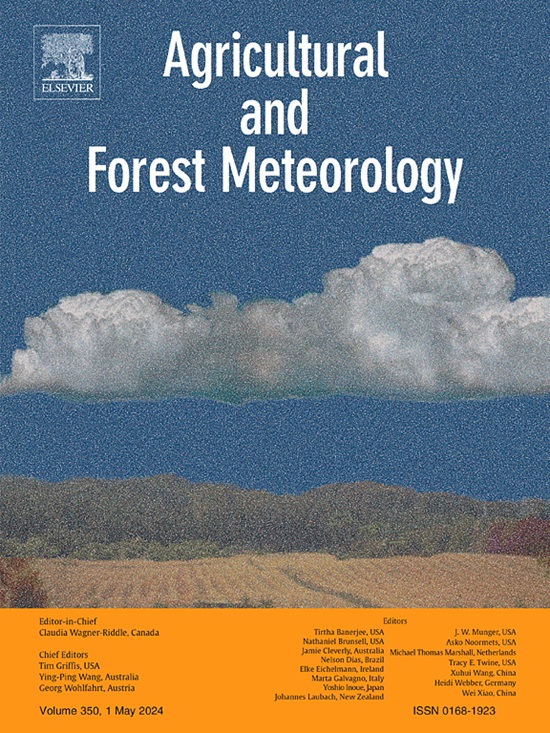An increasing delay in vegetation spring phenology over northern snow-covered landmass driven by temperature and snowmelt
IF 5.6
1区 农林科学
Q1 AGRONOMY
引用次数: 0
Abstract
The start of the growing season (SOS) has received much attention for its key role in the interactions between terrestrial ecosystems and the atmosphere. Recent studies have shown that the warming-induced SOS advancing trend in the Northern Hemisphere has slowed since 2000. This phenomenon is currently attributed mainly to a slowdown of the increase in preseason temperature (PT). However, snow cover dynamics, including the changes in maximum snow water equivalent (SWEmax) and snow cover end date (SCE), also have a significant impact on SOS over the northern snow-covered landmass, but their influence on the slowdown in the SOS advancing trend has not been thoroughly investigated. In this research, we first employed four commonly utilized methods for phenological extraction to extract SOS and its associated trends. We then evaluated the response of SOS to PT, SWEmax and SCE, and determined the relative importance of these three influencing factors. Our results showed that in the northern non-mountainous snowy areas: (1) The slowdown in the overall SOS advancing trend after 2000 can be attributed to the increasing delay in the SOS between 60°N and 70°N. (2) The impact of SWEmax on SOS is negligible in most regions, except for some regions in the northern Chukotka Peninsula and southern Eurasia. In temperate zones, SOS is primarily driven by PT, while in Arctic-boreal zones, it is mainly influenced by both PT and SCE. (3) The expansion of the decreasing trend in PT and the delayed trend in SCE between 60°N and 70°N after 2000 were the primary cause of the increasing delay in SOS. Our study confirms, for the first time, that the delay in SCE is an important but neglected factor contributing to the slowdown of the SOS advancing trend in the Northern Hemisphere after 2000.
在温度和融雪的驱动下,北方积雪陆地植被春季物候日益推迟
生长季节的开始(SOS)在陆地生态系统与大气之间的相互作用中发挥着关键作用,因而备受关注。最近的研究表明,自 2000 年以来,北半球由气候变暖引起的 SOS 提前趋势已经放缓。这一现象目前主要归因于季前温度(PT)上升的减缓。然而,雪盖动力学,包括最大雪水当量(SWEmax)和雪盖结束日期(SCE)的变化,也对北雪盖陆地上的 SOS 有重要影响,但它们对 SOS 推进趋势放缓的影响尚未得到深入研究。在这项研究中,我们首先采用了四种常用的物候提取方法来提取 SOS 及其相关趋势。然后,我们评估了 SOS 对 PT、SWEmax 和 SCE 的响应,并确定了这三个影响因素的相对重要性。结果表明,在北部非山地积雪区:(1)2000 年后,SOS 的总体上升趋势放缓,这可能是由于北纬 60 度至 70 度之间的 SOS 越来越延迟所致。(2)除楚科奇半岛北部和欧亚大陆南部的一些地区外,SWEmax 对大部分地区 SOS 的影响可以忽略不计。在温带地区,SOS 主要受 PT 的驱动,而在北极-寒带地区,SOS 主要受 PT 和 SCE 的影响。(3) 2000 年后,北纬 60 度和 70 度之间 PT 下降趋势的扩大和 SCE 趋势的延迟是 SOS 延迟增加的主要原因。我们的研究首次证实,SCE的延迟是导致2000年后北半球SOS上升趋势减缓的一个重要因素,但却被忽视了。
本文章由计算机程序翻译,如有差异,请以英文原文为准。
求助全文
约1分钟内获得全文
求助全文
来源期刊
CiteScore
10.30
自引率
9.70%
发文量
415
审稿时长
69 days
期刊介绍:
Agricultural and Forest Meteorology is an international journal for the publication of original articles and reviews on the inter-relationship between meteorology, agriculture, forestry, and natural ecosystems. Emphasis is on basic and applied scientific research relevant to practical problems in the field of plant and soil sciences, ecology and biogeochemistry as affected by weather as well as climate variability and change. Theoretical models should be tested against experimental data. Articles must appeal to an international audience. Special issues devoted to single topics are also published.
Typical topics include canopy micrometeorology (e.g. canopy radiation transfer, turbulence near the ground, evapotranspiration, energy balance, fluxes of trace gases), micrometeorological instrumentation (e.g., sensors for trace gases, flux measurement instruments, radiation measurement techniques), aerobiology (e.g. the dispersion of pollen, spores, insects and pesticides), biometeorology (e.g. the effect of weather and climate on plant distribution, crop yield, water-use efficiency, and plant phenology), forest-fire/weather interactions, and feedbacks from vegetation to weather and the climate system.

 求助内容:
求助内容: 应助结果提醒方式:
应助结果提醒方式:


